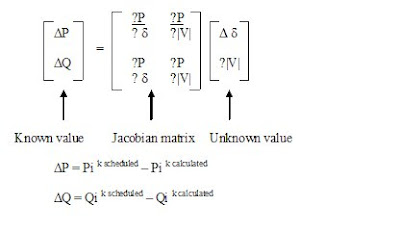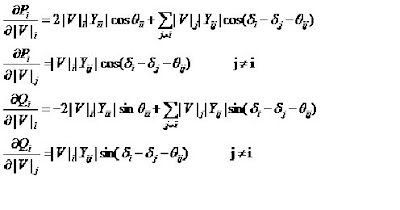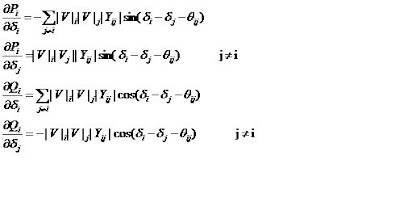1) Programming
-develop the web based (newton-raphson method) using PHP language and MySQL data based.
2) Integrate with CMS Joomla!
3) Testing with IEEE bus data.
4) Comparing the output result with stand alone program
Friday, November 2, 2007
Wednesday, October 31, 2007
1. INTRODUCTION
1.1 INTRODUCTION
The load flow study reveals the electrical performance and power flow (real and reactive) for specified conditions when the system is operating under steady-state [1]. Load flow study commonly used iterative techniques for the solution of non linear algebraic equation. These technique are applied to the practical systems using the develop software modules [2].
The program of load flow analysis of Newton-Raphson method will be done using the component based methodology. Component based development is reusable and can increase the efficiency of commercial offering of power system software.
The advantage of the component web based is that the component can be installed into integrated development environment (IDE) and simplifies system maintenance and modifications [3, 4].
Since each on the components is loosely coupled, users are free to upgrade and/or add components as needed without affecting other parts of the system. And since a component can be built and then continuously improved upon by an expert of organization the quality of a component based application will improve over time [3].
Component based system is link with content management system (CMS) Joomla!. Joomla! is using the open CMS such as PHP language and MySQL database [4]. PHP is a server side; HTML embedded scripting language used to create dynamics web pages. The user can jump between HTML and PHP instead of having to rely on heavy amount of code to output HTML because PHP is embedded within tags. The user cannot view the PHP code because PHP is executed on the server. PHP is an open source [5].
In recent times, open source software has been seen as an increasingly mainstream part of the market. This has been fuelled by the growth of the internet. The use of open source CMS has a benefit to user such as it is low cost. The code of open source content management systems can be obtained for free, and any commercial support associated with the product is typically comparable or cheaper than other product [6].
The other advantage of the open source CMS is easy to integrate with other software because it is an open platform. Open platform also increase the amount of supporting software and experience that is available. The ability to customize and extend the program has already been well-tested [7].
1.2 Aim of the ProjectThe main objective of this project is to develop a power system load flow program using component web based methodology. The program is using PHP language and MySQL database. The program developed will be integrated with CMS Joomla!. The program will be testing with the IEEE data and be compared with the existing stand alone program, MATLAB.
The load flow study reveals the electrical performance and power flow (real and reactive) for specified conditions when the system is operating under steady-state [1]. Load flow study commonly used iterative techniques for the solution of non linear algebraic equation. These technique are applied to the practical systems using the develop software modules [2].
The program of load flow analysis of Newton-Raphson method will be done using the component based methodology. Component based development is reusable and can increase the efficiency of commercial offering of power system software.
The advantage of the component web based is that the component can be installed into integrated development environment (IDE) and simplifies system maintenance and modifications [3, 4].
Since each on the components is loosely coupled, users are free to upgrade and/or add components as needed without affecting other parts of the system. And since a component can be built and then continuously improved upon by an expert of organization the quality of a component based application will improve over time [3].
Component based system is link with content management system (CMS) Joomla!. Joomla! is using the open CMS such as PHP language and MySQL database [4]. PHP is a server side; HTML embedded scripting language used to create dynamics web pages. The user can jump between HTML and PHP instead of having to rely on heavy amount of code to output HTML because PHP is embedded within tags. The user cannot view the PHP code because PHP is executed on the server. PHP is an open source [5].
In recent times, open source software has been seen as an increasingly mainstream part of the market. This has been fuelled by the growth of the internet. The use of open source CMS has a benefit to user such as it is low cost. The code of open source content management systems can be obtained for free, and any commercial support associated with the product is typically comparable or cheaper than other product [6].
The other advantage of the open source CMS is easy to integrate with other software because it is an open platform. Open platform also increase the amount of supporting software and experience that is available. The ability to customize and extend the program has already been well-tested [7].
1.2 Aim of the ProjectThe main objective of this project is to develop a power system load flow program using component web based methodology. The program is using PHP language and MySQL database. The program developed will be integrated with CMS Joomla!. The program will be testing with the IEEE data and be compared with the existing stand alone program, MATLAB.
Tuesday, October 30, 2007
2. LITERATURE REVIEW
2.1 Introduction
The program for power flow solution using Newton-Raphson method has already developed by Prof. Hadi Saadat of Milwauke University, USA in MATLAB [2]. MATLAB is an interpreted language for numerical computation. MATLAB allows its users to solve problems, produce graphics easily and produce code. The MATLAB code is easy to debug [8].
The MATLAB program is simple to use but lacks of many features in commercial power flow program. These MATLAB program is a stand alone program, therefore it need to be install before user can use it. Because MATLAB is an interpreted language, it can be slow, and poor programming practices can make it acceptably slow [9, 10].
2.2 Load flow analysis
Load flow solution is a solution of the network under steady state condition subjected to certain inequality constraints under which the system operates. These constraints can be in the form of load magnitude, bus voltages, reactive power generation of the generators, tap settings of a tap-changing transformer etc. The load flow solution gives the bus voltages and phase angles, hence the power injection at all the buses and power flow through interconnecting transmission lines can be easily calculated. Load flow solution is essential for designing a new power system as well as for planning an extension or operation of the existing one for varying demand. These analyses require number of load flow solutions under both normal and abnormal (outage of transmission line or outage of some generators) operating conditions. Load flow solution also gives the initial state of the system when the transient behavior of the system is to be studied. Under steady state condition, the network equations will be in the form of simple algebraic equations.
The program for power flow solution using Newton-Raphson method has already developed by Prof. Hadi Saadat of Milwauke University, USA in MATLAB [2]. MATLAB is an interpreted language for numerical computation. MATLAB allows its users to solve problems, produce graphics easily and produce code. The MATLAB code is easy to debug [8].
The MATLAB program is simple to use but lacks of many features in commercial power flow program. These MATLAB program is a stand alone program, therefore it need to be install before user can use it. Because MATLAB is an interpreted language, it can be slow, and poor programming practices can make it acceptably slow [9, 10].
2.2 Load flow analysis
Load flow solution is a solution of the network under steady state condition subjected to certain inequality constraints under which the system operates. These constraints can be in the form of load magnitude, bus voltages, reactive power generation of the generators, tap settings of a tap-changing transformer etc. The load flow solution gives the bus voltages and phase angles, hence the power injection at all the buses and power flow through interconnecting transmission lines can be easily calculated. Load flow solution is essential for designing a new power system as well as for planning an extension or operation of the existing one for varying demand. These analyses require number of load flow solutions under both normal and abnormal (outage of transmission line or outage of some generators) operating conditions. Load flow solution also gives the initial state of the system when the transient behavior of the system is to be studied. Under steady state condition, the network equations will be in the form of simple algebraic equations.
2.2.1 Bus Classification
In a power system each bus or node is associated with four quantities, real and reactive powers, bus voltage magnitudes and its phase angles. In a load flow solution two out of four quantities are specified and the remaining two are to be calculated through the solution of the equations. The buses are classified into the following three types depending upon the quantities specified.
1 Load bus: At this bus the real and reactive components of power are specified. It is desired to find out the voltage magnitude V and phase angle δ through the load flow solution. Voltage at load bus can be allowed to vary within a prescribed value.
2 Generator bus or voltage-controlled bus: Here the voltage magnitude corresponding to the generator voltage V and real power PG corresponding to its ratings is specified. It is required to find out the reactive power generation QG and the phase angle δ of the bus.
3 Slack/Swing or reference bus: Here the voltage magnitude V and phase angle δ is specified. This will take care of the additional power generation required and Transmission losses. It is required to find the real and reactive power generations (PG, QG) at this bus.
2.3 Newton-Raphson load flow (NRLF) Method
2.3.1 Calculation of Jacobian
For an N-bus power system there will be n equations for real power injection P i and n-equations for reactive power injection Q i .

For load buses, voltage magnitudes and phase angle are set to 1.0 and 0.0 respectively.
For voltage-regulated buses phase angle are set to 0.0.
The number of equations to be solved depends upon the specifications we have. If the total number of buses is N;
N = number of PV bus – [2 x number of PQ bus]
Unknowns to be calculated are power angles (δ) at all the buses except slack and bus voltages (V) at load bus. The following method known as Newton- Raphson method is used for solving the unknown quantities. The problem formulation is as follows:
For voltage-regulated buses phase angle are set to 0.0.
The number of equations to be solved depends upon the specifications we have. If the total number of buses is N;
N = number of PV bus – [2 x number of PQ bus]
Unknowns to be calculated are power angles (δ) at all the buses except slack and bus voltages (V) at load bus. The following method known as Newton- Raphson method is used for solving the unknown quantities. The problem formulation is as follows:

The elements of the Jacobian matrix can be calculated using the following equations



Procedure for this iterative method is for the given system first the Y-bus matrix has to be formed.
Y = G + j B
Where
Y is a bus admittance matrix
G is real part of Y-bus matrix
B is imaginary part of Y-bus matrix
The resistance and reactance of each line have been given for any system from which the admittance matrix can be formed.
Inverse the Jacobian matrix and from matrix equation solve for DVik and D d ik
The new voltage magnitude and phase angles are computed from


k = current iteration
k+1 = next iteration
The calculation process for Vi k+1 and di k+1 stop when the DPik, DQik, DVik and D d ik are very small.
The process is continued until the residuals DPik and DQik are less than the specified accuracy i.e,
k+1 = next iteration
The calculation process for Vi k+1 and di k+1 stop when the DPik, DQik, DVik and D d ik are very small.
The process is continued until the residuals DPik and DQik are less than the specified accuracy i.e,

3. CONCLUSION
This report describes the development of web based power system load flow (Newton-Raphson) component using component based methodology. The advantage of component web base is accessibility which is easy to be installed. It also has low maintenance and also low cost.
REFERRENCES
[1] B.R. Gupta, S.Chand “Power System Analysis and Design”
[2] Prof. Hadi Saadat, “Power System Analysis, 2nd Edition, Mc Graw Hill.”
[3] Khalid Mohamed Nor, Taufiq Abdul Gani, Hazlie Mokhlis “The Application of The Component Based Methodology in Developing Visual Power System Analysis Tool, 2001 IEEE”.
[4] “Joomla! What is Joomla!?” – www.joomla.org
[5] “What is PHP?” – www.techiwarehouse.com
[6] “Open-source content management systems by James Robertson”
Published on 6 February 2004 – www.steptwo.com.au
[7] “About Component Based Development. The Componentization of Software” – webcomponents.com
[8] David Eyre, “MATLAB Basics and a little Beyond” – www.math.utah.edu
[9] Stephen J. Chapman, “Electrical Machinery and Power System Fundamentals, Mc Graw Hill, International Edition.”
[10] “Why MATLAB” – bnt.sourceforge.net
[2] Prof. Hadi Saadat, “Power System Analysis, 2nd Edition, Mc Graw Hill.”
[3] Khalid Mohamed Nor, Taufiq Abdul Gani, Hazlie Mokhlis “The Application of The Component Based Methodology in Developing Visual Power System Analysis Tool, 2001 IEEE”.
[4] “Joomla! What is Joomla!?” – www.joomla.org
[5] “What is PHP?” – www.techiwarehouse.com
[6] “Open-source content management systems by James Robertson”
Published on 6 February 2004 – www.steptwo.com.au
[7] “About Component Based Development. The Componentization of Software” – webcomponents.com
[8] David Eyre, “MATLAB Basics and a little Beyond” – www.math.utah.edu
[9] Stephen J. Chapman, “Electrical Machinery and Power System Fundamentals, Mc Graw Hill, International Edition.”
[10] “Why MATLAB” – bnt.sourceforge.net
Subscribe to:
Comments (Atom)
